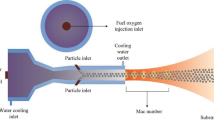Abstract
Residual stress in high velocity oxy-fuel (HVOF) thermally sprayed WC-10Co-4Cr coating was studied based on design of experiment (DOE) with five factors of oxygen flow, fuel gas hydrogen flow, powder feed rate, stand-off distance, and surface speed of substrate. In each DOE run, the velocity and temperature of in-flight particle in flame, and substrate temperature were measured. Almen-type N strips were coated, and their deflections after coating were used for evaluation of residual stress level in the coating. The residual stress in the coating obtained in all DOE runs is compressive. In the present case of HVOF thermally sprayed coating, the residual stress is determined by three types of stress: peening, quenching, and cooling stress generated during spraying or post spraying. The contribution of each type stress to the final compressive residual stress in the coating depends on material properties of coating and substrate, velocity and temperature of in-flight particle, and substrate temperature. It is found that stand-off distance is the most important factor to affect the final residual stress in the coating, following by two-factor interaction of oxygen flow and hydrogen flow. At low level of stand-off distance, higher velocity of in-flight particle in flame and higher substrate temperature post spraying generate more peening stress and cooling stress, resulting in higher compressive residual stress in the coating.











Similar content being viewed by others
References
B. Startwell, Thermal Spray Coatings as Alternative to Hard Chrome Plating, Weld. J., 2000, 79, p 39–43
D. Lee, R. Eybel, and R. Evans, Development and Implementation of HVOF WC/Co/Cr Coating as Alternative to Electrolytic Hard Chrome Plate in Landing Gear Applications Using Natural Gas as Fuel, Thermal Spray 2003: Advancing the Science and Applying the Technology, ASM International, 2003, p 371–376
R. Evans, R. Panza-Giosa, E. Cochien, and S. Maitland, HVOF-Applied WC-Co-Cr as a Hard Chrome Replacement for Landing Gear, Thermal Spray 2006: Science, Innovation, and Application: Proceedings of the Spray Conference, ASM International, 2006, p 615–617
P.F. Ruggiero, Tungsten Carbide Coatings Replace Chromium, Adv. Mater. Process., 2005, 163(7), p 39–40
R. Schwetzke and H. Kreye, Microstructure and Properties of Tungsten Carbide Coatings Sprayed with Various High-Velocity Oxygen Fuel Spray Systems, J. Therm. Spray Technol., 1999, 8, p 433–439
J.M. Guilemany, S. Dosta, J. Nin, and J.R. Miguel, Study of the Properties of WC-Co Nanostructured Coatings Sprayed by High-Velocity Oxyfuel, J. Therm. Spray Technol., 2005, 14, p 405–413
J.G. Legoux, S. Bouaricha, and J.P. Sauer, Cracking and Spalling Behavior of WC-17%Co Cermet Coatings, Thermal Spray 2006: Science, Innovation, and Application: Proceedings of the Spray Conference, ASM International, 2006, p 609–661
A. Ghabchi, T. Varis, E. Turunen, T. Suhonen, X. Liu, and S.P. Hannula, Behavior of HVOF WC-10Co-4Cr Coatings with Different Carbide Size in Fine and Coarse Particle Abrasion, J. Therm. Spray Technol., 2010, 19, p 368–377
L. Prchlik, S. Sampath, J. Gutleber, G. Banche, and A.W. Ruff, Friction and Wear Properties of WC-Co and Mo-Mo2C Based Functionally Graded Materials, Wear, 2001, 8, p 1103–1115
M.Y.P. Costa, M.L.R. Venditti, H.J.C. Voorwald, M.O.H. Cioffi, and T.G. Cruz, Effect of WC-10%Co-4%Cr on the Ti-6Al-4V Alloy Fatigue Strength, Mater. Sci. Eng., 2009, 507 A, p 29–36
A.K. Maiti, N. Mukhopadhyay, and R. Raman, Improving the Wear Behavior of WC-CoCr-Based HVOF Coating by Surface Grinding, J. Mater. Eng. Perform., 2009, 18, p 1060–1066
J.C. Tan, L. Looney, and M.S.J. Hashmi, Residual Stress Analysis of WC-Co Solid Components Formed by HVOF Thermal Spraying Process, Proc. Adv. Powder Metall. Part. Mater. Wash. DC, 1996, 3, p 941–952
J. Stokes and L. Looney, Residual Stress in HVOF Thermally Sprayed Thick Deposits, Surf. Coat. Technol., 2004, 177–178, p 18–23
J.P. Sauer and P. Sahoo, HVOF Process Control Using Almen and Temperature Measurement, Thermal Spray 2001: New Surface for a New Millennium: Proceedings of the International Thermal Spray Conference, ASM International, 2001, p 791–796
J. Stokes and L. Looney, Properties of WC-Co Components Produced Using the HVOF, Thermal Spray Process, Proceedings of 2000 Thermal Spray Conference, ASM International, 2000, p 263–271
M. Gaona, R.S. Lima, and B.R. Marple, Influence of Particle Temperature and Velocity on the Microstructure and Mechanical Behavior of High Velocity Oxy-Fuel (HVOF)-Sprayed Nanostructured Titania Coatings, J. Mater. Process. Technol., 2008, 198, p 426–435
J. Matejicek and S. Sampath, In Situ Measurement of Residual Stresses and Elastic Moduli in Thermal Sprayed Coatings: Part 1: Apparatus and Analysis, Acta Mater., 2003, 51, p 863–872
S. Sampath, V. Sirnivasan, A. Valarezo, A. Vaidya, and T. Streibl, Sensing, Control, and In Situ Measurement of Coating Properties: An Integrated Approach Toward Establishing Process-Property Correlations, J. Therm. Spray Technol., 2009, 18, p 243–255
O.C. Brandt, Measuring of Residual Stresses in Thermal Sprayed Coatings, Proceeding of Eight National Thermal Spray Conference 1995 (Texas, USA), 1995, p 451–455
L. Zhao, M. Maurer, F. Fischer, and E. Lugscheider, Study of HVOF Spraying of WC-CoCr Using On-line Particle Monitoring, Surf. Coat. Technol., 2004, 185, p 160–165
J.P. Sauer and M. Carroll, Thermal Spray Process Training—A New Perspective, International Thermal Spray Conference & Exposition 2009, 4–7 May (Las Vegas, USA), 2009
S. Kuroda, Y. Tashiro, H. Yumoto, S. Taira, H. Fukanuma, and S. Tobe, Peening Action and Residual Stress in High-velocity Oxygen Fuel Thermal Spraying of 316L Stainless Steel, J. Therm. Spray Technol., 2001, 10, p 367–374
J. Stokes and L. Looney, Predicting Quenching and Cooling Stresses within HVOF Deposits, J. Therm. Spray Technol., 2008, 17, p 908–914
T.W. Clyne, Residual Stresses in Coated and Layered Systems, Encyclopaedia of Materials: Science and Technology—Elasticity and Residual Stress, P.J. Withers, Ed., Elsevier, 2001, p 8126–8134
D.J. Lloyd, Particle Reinforced Aluminum and Magnesium Matrix Composites, Int. Mater. Rev., 1994, 39, p 1–23
Author information
Authors and Affiliations
Corresponding author
Rights and permissions
About this article
Cite this article
Gui, M., Eybel, R., Asselin, B. et al. Influence of Processing Parameters on Residual Stress of High Velocity Oxy-Fuel Thermally Sprayed WC-Co-Cr Coating. J. of Materi Eng and Perform 21, 2090–2098 (2012). https://doi.org/10.1007/s11665-012-0134-2
Received:
Accepted:
Published:
Issue Date:
DOI: https://doi.org/10.1007/s11665-012-0134-2




